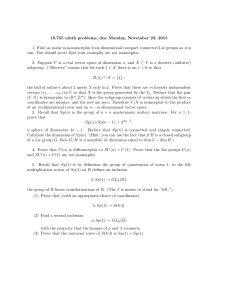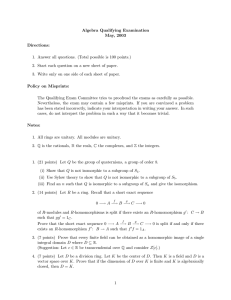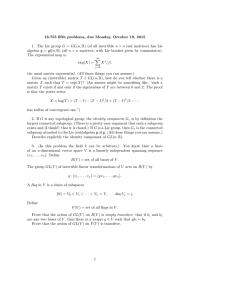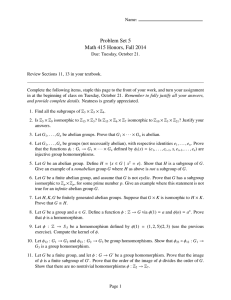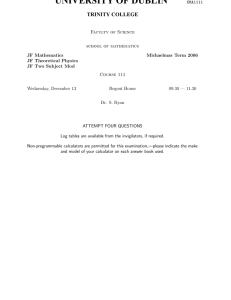18.755 ninth problems solutions
advertisement
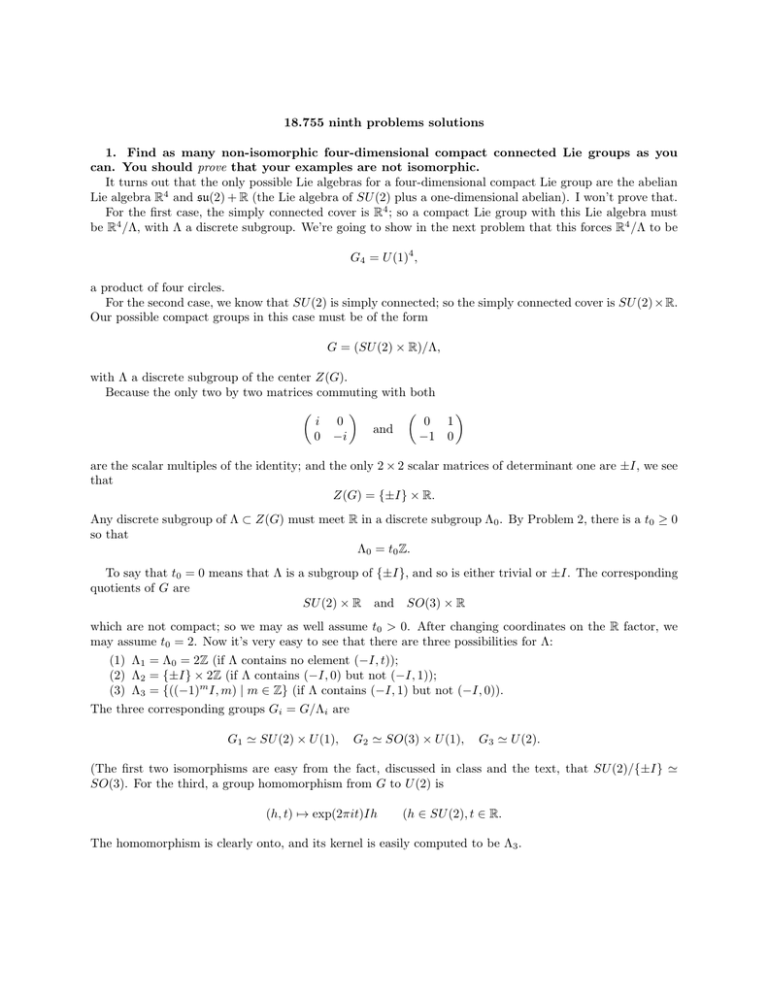
18.755 ninth problems solutions
1. Find as many non-isomorphic four-dimensional compact connected Lie groups as you
can. You should prove that your examples are not isomorphic.
It turns out that the only possible Lie algebras for a four-dimensional compact Lie group are the abelian
Lie algebra R4 and su(2) + R (the Lie algebra of SU (2) plus a one-dimensional abelian). I won’t prove that.
For the first case, the simply connected cover is R4 ; so a compact Lie group with this Lie algebra must
be R4 /Λ, with Λ a discrete subgroup. We’re going to show in the next problem that this forces R4 /Λ to be
G4 = U (1)4 ,
a product of four circles.
For the second case, we know that SU (2) is simply connected; so the simply connected cover is SU (2) × R.
Our possible compact groups in this case must be of the form
G = (SU (2) × R)/Λ,
with Λ a discrete subgroup of the center Z(G).
Because the only two by two matrices commuting with both
i
0
0
−i
and
0 1
−1 0
are the scalar multiples of the identity; and the only 2 × 2 scalar matrices of determinant one are ±I, we see
that
Z(G) = {±I} × R.
Any discrete subgroup of Λ ⊂ Z(G) must meet R in a discrete subgroup Λ0 . By Problem 2, there is a t0 ≥ 0
so that
Λ0 = t0 Z.
To say that t0 = 0 means that Λ is a subgroup of {±I}, and so is either trivial or ±I. The corresponding
quotients of G are
SU (2) × R and SO(3) × R
which are not compact; so we may as well assume t0 > 0. After changing coordinates on the R factor, we
may assume t0 = 2. Now it’s very easy to see that there are three possibilities for Λ:
(1) Λ1 = Λ0 = 2Z (if Λ contains no element (−I, t));
(2) Λ2 = {±I} × 2Z (if Λ contains (−I, 0) but not (−I, 1));
(3) Λ3 = {((−1)m I, m) | m ∈ Z} (if Λ contains (−I, 1) but not (−I, 0)).
The three corresponding groups Gi = G/Λi are
G1 ≃ SU (2) × U (1),
G2 ≃ SO(3) × U (1),
G3 ≃ U (2).
(The first two isomorphisms are easy from the fact, discussed in class and the text, that SU (2)/{±I} ≃
SO(3). For the third, a group homomorphism from G to U (2) is
(h, t) 7→ exp(2πit)Ih
(h ∈ SU (2), t ∈ R.
The homomorphism is clearly onto, and its kernel is easily computed to be Λ3 .
2
Because G4 is abelian, it is obviously not isomorphic to any of G1 , G2 , or G3 . The centers of these last
three groups are
Z(G1 ) ≃ {±I} × U (1), Z(G2 ) ≃ U (1), Z(G3 ) ≃ U (1).
(In the last case the reason is that the center of U (2) consists of the scalar matrices in U (2).) It follows that
G1 is not isomorphic to G2 or to G3 . The derived group (subgroup generated by commutators) of any G/Λ
is G′ /(Λ ∩ G′ ) (with G′ = SU (2) the derived group of G.) We therefore find
G′1 ≃ SU (2),
G′2 ≃ SO(3),
G′3 ≃ SU (2).
Therefore G2 is not isomorphic to G1 or to G3 , completing the proof that the four groups are not isomorphic.
You might think about whether you can find two nonisomorphic compact connected Lie groups H1 and
H2 with Z(H1 ) ≃ Z(H2 ) and H1′ ≃ H2′ .
2. Suppose V is a real vector space of dimension n, and X ⊂ V is a discrete (additive)
subgroup. (“Discrete” means that for each ξ ∈ X there is an ǫ > 0 so that
Bǫ (ξ) ∩ X = {ξ}:
the ball of radius ǫ about ξ meets X only in ξ.) Prove that there are m linearly independent
vectors (v1 , . . . , vm ) in V so that X is the group generated by the Vj . Deduce that the pair
(V, X) is isomorphic to (Rn , Zm ). Here the subgroup consists of vectors in which the first m
coordinates are integers, and the rest are zero. Therefore V /X is isomorphic to the product of
an m-dimensional torus and an n − m-dimensional vector space.
For the moment I’m too lazy to write a solution for this problem. Please ask if you’d like me to do that.
3. Recall that Sp(n) is the group of n × n quaternionic unitary matrices. For n ≥ 1, prove
that
Sp(n)/Sp(n − 1) ≃ S 4n−1 ,
a sphere of dimension 4n − 1. Deduce that Sp(n) is connected and simply connected. Calculate
the dimension of Sp(n). (Hint: you can use the fact that if H is a closed subgroup of a Lie
group G, then G/H is a manifold of dimension equal to dim G − dim H.)
An element of g ∈ Sp(n) is an orthonormal basis of Hn with respect to the Hermitian form hv, wi = t vw
discussed in class; the pth column of g is g · ep , with (e1 , . . . , en ) the standard basis. Therefore Sp(n) · e1
consists of all unit vectors in Hn that can be first elements of an orthonormal basis. By the Gram-Schmidt
process, this is all unit vectors, so
Sp(n) · e1 = S 4n−1 ,
the manifold of all unit vectors in Hn . The stabilizer of e1 is
1
H = h ∈ Sp(n) | h =
0
t
w
h′
, w∈H
n−1
, h ∈ GL(n − 1, H) .
′
The columns of such an h are orthonormal if and only if w = 0 (this is the “orthogonal to e1 ” condition)
and h′ ∈ Sp(n − 1) (this is the condition that the last n − 1 columns are orthonormal). Therefore H is
isomorphic to Sp(n − 1). This completes the proof that Sp(n)/Sp(n − 1) ≃ S 4n−1 .
The homotopy long exact sequence for this homogeneous space, together with the fact that S 4n−1 is
connected and simply connected, says that (for n ≥ 1) π1 (Sp(n − 1)) maps onto π1 (Sp(n)), and that
3
π0 (Sp(n − 1)) is isomorphic to π0 (Sp(n)). Since Sp(0) is a point (which is connected and simply connected),
it follows by induction on n that Sp(n) is connected and simply connected.
Finally, according to the hint,
4n − 1 = dim S 4n−1 = dim Sp(n) − dim Sp(n − 1).
Since dim Sp(0) = 0, it follows by induction on n that dim Sp(n) = 2n2 + n.
4. Prove that U (n) is diffeomorphic to SU (n) × U (1). Prove that the Lie groups U (n) and
SU (n) × U (1) are not isomorphic.
The map
SU (n) × U (1) → U (n),
(h, t) 7→ h
t
0
0
In−1
is easily computed to have inverse
g 7→
det g −1
g
0
0
In−1
, det g −1 ,
and so to be a diffeomorphism.
The Lie algebras of these two groups are both isomorphic to su(n) ⊕ R. One way to prove that the Lie
groups are different is to write µn ⊂ C× for the group of nth roots of unity, and to compute
Z(SU (n)) = µn In ≃ µn ,
Z(SU (n) × U (1)) ≃ µn × U (1),
a disconnected group. The center of U (n) is
Z(U (n)) = {exp(iθ)In | θ ∈ R} ≃ U (1),
a connected group.
You might think about how many different compact connected Lie groups have Lie algebra su(n) ⊕ R.
(Hint: the answer is not n + 1.)
5. Recall that Sp(1) is by definition the group of quaternions of norm 1; so the left multiplication action of Sp(1) on H defines an inclusion
λ: Sp(1) → GLR (H),
the group of R-linear transformations of H. (The λ is meant to stand for “left.”)
(1) Prove that (with an appropriate choice of coordinates)
λ: Sp(1) → SO(4).
(2) Find a second inclusion
ρ: Sp(1) → GLR (H)
with the property that the images of ρ and λ commute.
(3) Prove that the universal cover of SO(4) is Sp(1) × Sp(1).
4
In the real basis (1, i, j, k) for H, the Hermitian form hv, wi = vw satisfies
ha + bi + cj + dk, a + bi + cj + dki = a2 + b2 + c2 + d2 ,
which is exactly the real quadratic form defining O(4). Left multiplication by z ∈ H satisfies
hzv, zwi = zvzw = v zzw = v|z|2 w = |z|2 hv, wi;
to do the commutation we use the fact that |z|2 is real and so central in H. So left multiplication by the
units Sp(1) preserves the Hermitian form; so it preserves Euclidean length, and therefore maps into O(4).
Because Sp(1) is connected, the Lie group homomorphism λ must carry it to the identity component SO(4)
of O(4).
A similar calculation shows that right multiplication
ρ: Sp(1) → GLR (H),
ρ(z)h = hz −1
preserves the length defined by the Hermitian form. (It does not preserve the Hermitian form itself, but
rather conjugates quaternionic values of the form by z.) So ρ(Sp(1)) ⊂ SO(4). In any associative ring, left
and right multiplication (by different elements) commute with each other: this statement
(ℓx)r = ℓ(xr)
is precisely the associative law. So the images of Sp(1) under λ and ρ commute with each other.
We have defined a homomorphism
λ × ρ: Sp(1) × Sp(1) → SO(4),
(z, w) 7→ [v 7→ zvw−1 ]
for unit quaternions z and w and arbitrary quaternions v. The kernel of this homomorphism is
{(z, w) ∈ Sp(1) × Sp(1) | v = zvw−1 , all v ∈ H}.
The requirement for v = 1 shows that z = w; the requirement for arbitrary v shows that z ∈ Z(H) = R.
The only length one elements of R are {±1}; so
ker(λ × ρ) = {(z, z) | z = ±1} ⊂ Sp(1) × Sp(1),
a two-element group. In particular, the image of λ × ρ must have the same dimension as Sp(1) × Sp(1),
which is 6.
Since SO(4) has dimension 6, it follows that λ × ρ is a covering map. Since Sp(1) × Sp(1) is simply
connected (Problem 4), this is the universal cover.
